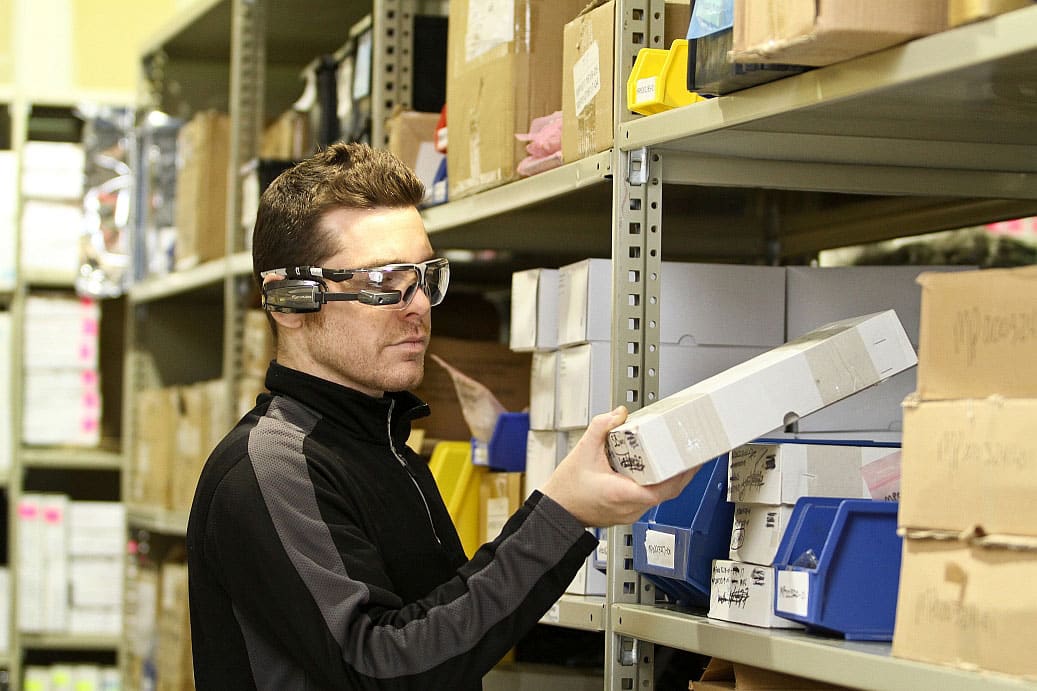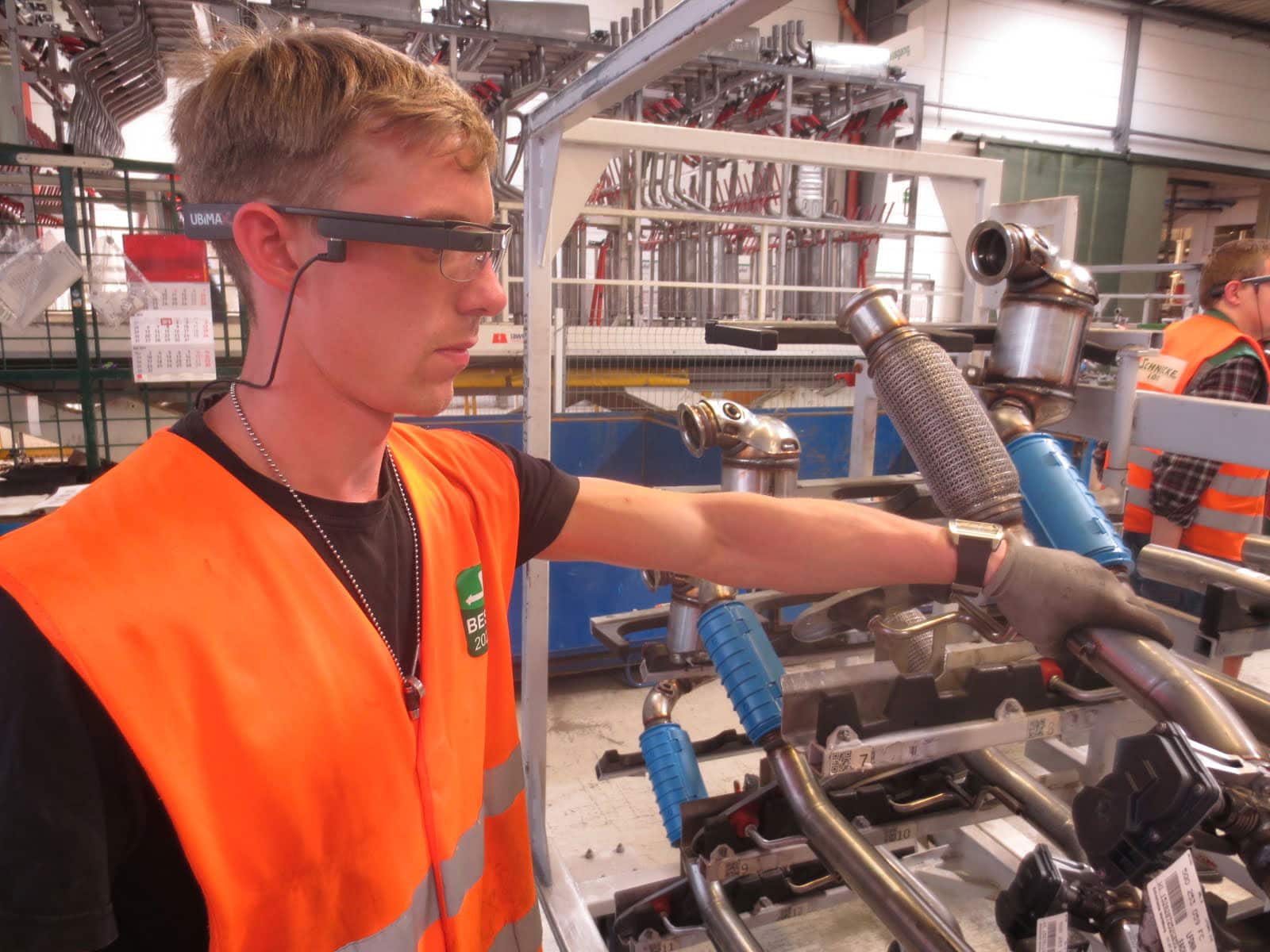Intelligent picking
Having items ready for assembly or delivery is a continuous and demanding activity in any large production and distribution site. This involves a significant number of employees to ensure a constant delivery flow. Their task is to access the goods stored in fixed locations manually. They must bring them to the intended department in the correct version, code and quantity. In some companies, the process is evolving. It is a timed search made by operators inside the warehouse, equipped with only a clipboard and pen. Such stressful and repetitive tasks can generate human errors. These errors may cause company losses.
-
Intelligent picking
Product information
These picking systems optimize processes that decrease the error rate of the picking team. They speed up the entire picking process and inventory. The concept bases on pick-by-vision technology. It combines augmented reality software with portable equipment (smart glasses). The operator connects to the system with the user data. An intuitive graphical interface on the respective wearable devices guides him in the warehouse. The software extracts information from the warehouse management system. It shows them to the operator in an optimized, step-by-step manner.
These special glasses resemble Google or Vuzix Glasses. They allow the users to see in front of their eyes a projection with the relevant details of the products they must extract. They can see the items’ location information and their picking route, as well. The see-through holographic lenses enable them to operate safely during the entire process. Their surroundings remain fully visible.
After the pick completes, the users have to confirm the operation. They confirm it by scanning a QR code with the smart glasses’ camera. Optional components and modules can be implemented to allow the pick confirmation. A few examples are voice confirmation, image recognition, motion command, weight control, sensor integration, RFID transponders or different barcode scanners.
During the picking procedures, the warehouse management system saves the information in real time. The packing lists update automatically in the background. The task completion or different incurring issues are reported instantly. The following pick task appears on the display. The system allows the responsible people to assign new tasks, manage the staff, generate and view reports and analyses. With maximum precision, it can handle one, two or three orders at a time. This depends on the application requirements.
Industrial wearable computing and augmented reality solutions sort, pick and output items. In addition to these operations, they handle other activities involving manual product selection. These include incoming goods, storage and inventory control, sequencing, replenishing and depositing. They cover logistics and warehousing processes as well.
Benefits
Manual logistics processes prevail in many companies. This places the human factor in an essential role when performing the picking activities. Automating the selection and retrieval of goods through vision-picking technology increases production. It improves the industrial workflow in logistics and intralogistics across different industries. Digitalization with vision-picking and augmented reality benefits contractors and their employees. This bases on the field’s most advanced equipment and solutions
Operation time reduction
Usual picking operations require a whole set of repetitive movements. They are time-consuming and less cost-effective. The operators must walk (while pushing a cart) or drive an industrial vehicle up to the targeted rack. They must search for the intended product, retrieve it, load it on the logistic equipment, and then check the pick. They must complete these fragmented handling steps for every single item. In such conditions, even small changes can turn into improvements.
The graphical view of the goods’ details allows the staff to consume the information within fractions of a second. The relevant data is in sight. Operators can access the products and confirm the pick quick and easy. The technology increases the operating speed. It boosts the production capacity at all working levels. Order picking by vision proved its efficacy by increasing order preparation speed by up to 35%. This compares to the previous scenario when hand scanners had to combine with paper lists. These were the results after leading distribution companies implemented the system.
Error rate decrease
Each pick is unique and requires optimum planning of the necessary steps to fulfill the right task. This solution enables the digital presentation of information, instructions and documents. It works by combining innovative pick-by-vision order picking with smart glasses. This connects devices, operators and processes along the supply chain. This way, work efficiency enhances at all levels. The error rate goes down to 0. This happens due to the automated instructions, gradual guidance and staged confirmation of the workflow.
Ergonomy
Visual augmented reality tools improve work efficiency. It simplifies internal processes for employees outside the office and far from desks. The sorting and picking procedures can occur without hand-held scanning equipment or printed paper pick lists. It happens by displaying the information on wearable devices. This way, operators have both hands free to move and perform their tasks much faster.
The walking distances minimize by overlapping the real world with the digital one (augmented reality). They visualize concrete instructions and information. In consequence, employees are more satisfied and productive in daily tasks. The smart glasses have an ergonomic design and a low weight. This makes them comfortable to wear by the operators. Barcode and RFID scanners can be added as rings or wristbands to offer increased comfort. This helps with locations that are hard to reach.
Flexibility
Pick-by-vision with smart glasses eliminates the necessity of consulting printed-on paper lists. This way, operators have both hands free and increased mobility to handle the items faster and easier. This offers them great agility, especially in those warehouses or production sites with constant changes. They occur as on-shelf-electronics or rack-mounted equipment are omitted from the system.
Pick-by-view does not require extensive training and is simple to operate. This makes it suitable for various working environments. The new employees are trained on the job and quickly become productive. They can shortly fulfill the incoming task by having assigned a new workflow.
Customisation
Intelligent manual picking technology is suitable for small parts and packages. The users can select components from the modular concept software to create a tailor-made solution. In addition, the specific structure of the user interface can have a display for each picker. This is possible by using, for example, different languages or qualifying levels. The system is adaptable to changes made inside the warehouse. This happens due to the adaptive workflow. It can include smartphones, smartwatches, tablets or combinations of these output devices. In addition, it can integrate any required element, such as graphics and video.
This smart order-picking system is designed to be independent of hardware producers and distributors. The picking method provides a wireless connection and does not require additional technologies.
Real time operation
The augmented vision for order picking uses data analytics and artificial intelligence. The purpose is to offer enterprise customers relevant industry-specific solutions. The fast and steady picking performance during the work shift correlates with rapid input and output processing. The information updates in real time inside the internal management system. It is conveyed to all levels of the logistics chain. Contact with other people from the team or other departments is open and can be done in all directions.
Other picking techonologies
An extensive range of modular and efficient picking solutions is available. They are adaptable for each industry. Pick-to-light technology, for example, can be implemented in warehouses and distribution hubs, as well. The method uses lights and LED systems mounted on the racks or shelves. They indicate the pick locations, guide the operators and help them identify the picking items. The method is more efficient than RF picking or paper-printed pick lists.
The system sends alerts to other warehouse employees when stocks of a certain product are low to replenish them. Pick-to-light systems are custom. Wholesale and retail companies can use them to hold various small and bulky products. Other logistic equipment, such as carts and trolleys, can facilitate order picking.



